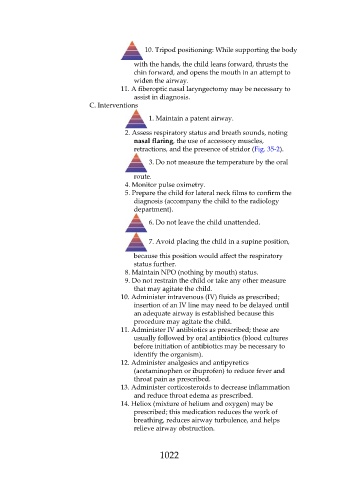Page 1022 - Saunders Comprehensive Review For NCLEX-RN
P. 1022
10. Tripod positioning: While supporting the body
with the hands, the child leans forward, thrusts the
chin forward, and opens the mouth in an attempt to
widen the airway.
11. A fiberoptic nasal laryngectomy may be necessary to
assist in diagnosis.
C. Interventions
1. Maintain a patent airway.
2. Assess respiratory status and breath sounds, noting
nasal flaring, the use of accessory muscles,
retractions, and the presence of stridor (Fig. 35-2).
3. Do not measure the temperature by the oral
route.
4. Monitor pulse oximetry.
5. Prepare the child for lateral neck films to confirm the
diagnosis (accompany the child to the radiology
department).
6. Do not leave the child unattended.
7. Avoid placing the child in a supine position,
because this position would affect the respiratory
status further.
8. Maintain NPO (nothing by mouth) status.
9. Do not restrain the child or take any other measure
that may agitate the child.
10. Administer intravenous (IV) fluids as prescribed;
insertion of an IV line may need to be delayed until
an adequate airway is established because this
procedure may agitate the child.
11. Administer IV antibiotics as prescribed; these are
usually followed by oral antibiotics (blood cultures
before initiation of antibiotics may be necessary to
identify the organism).
12. Administer analgesics and antipyretics
(acetaminophen or ibuprofen) to reduce fever and
throat pain as prescribed.
13. Administer corticosteroids to decrease inflammation
and reduce throat edema as prescribed.
14. Heliox (mixture of helium and oxygen) may be
prescribed; this medication reduces the work of
breathing, reduces airway turbulence, and helps
relieve airway obstruction.
1022

